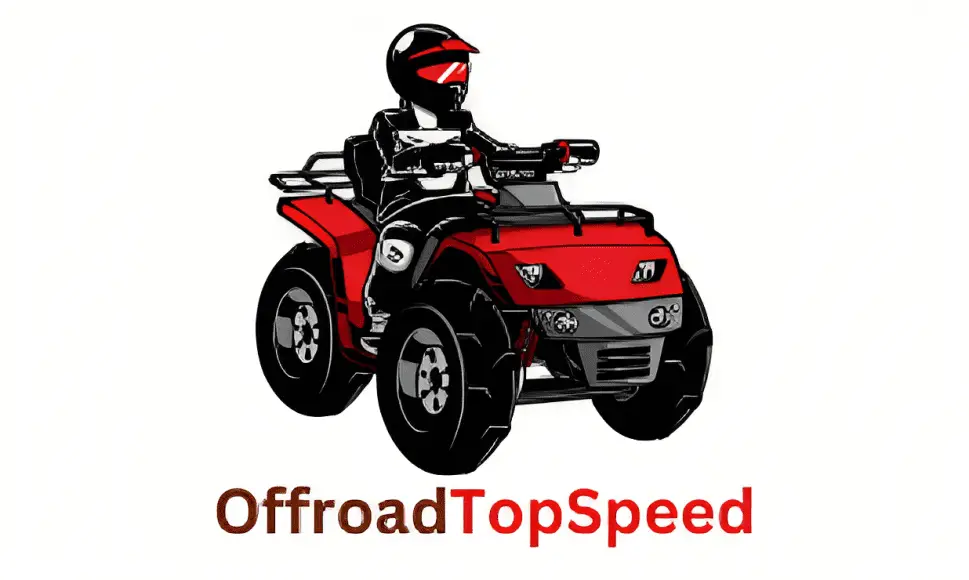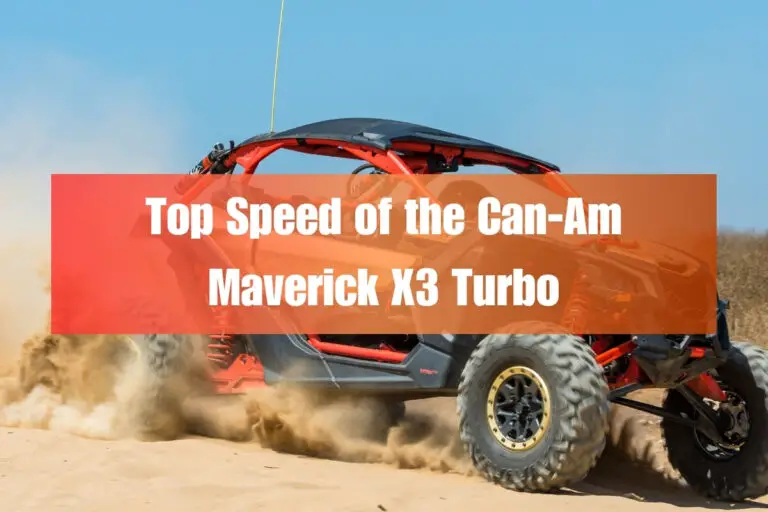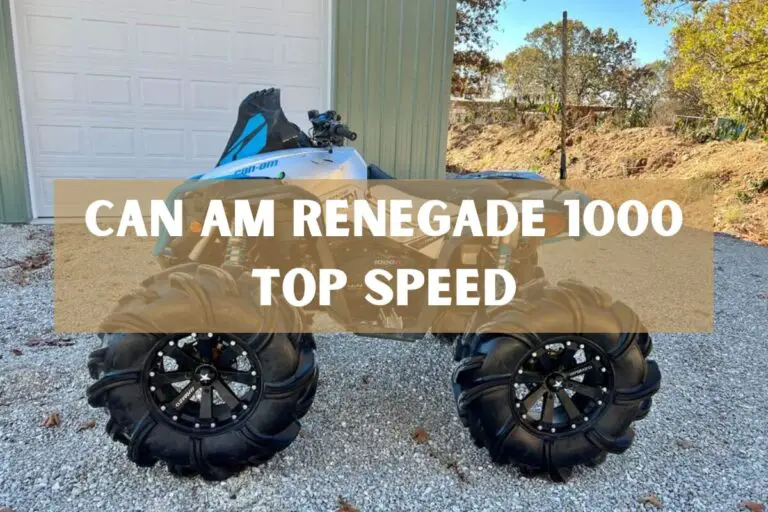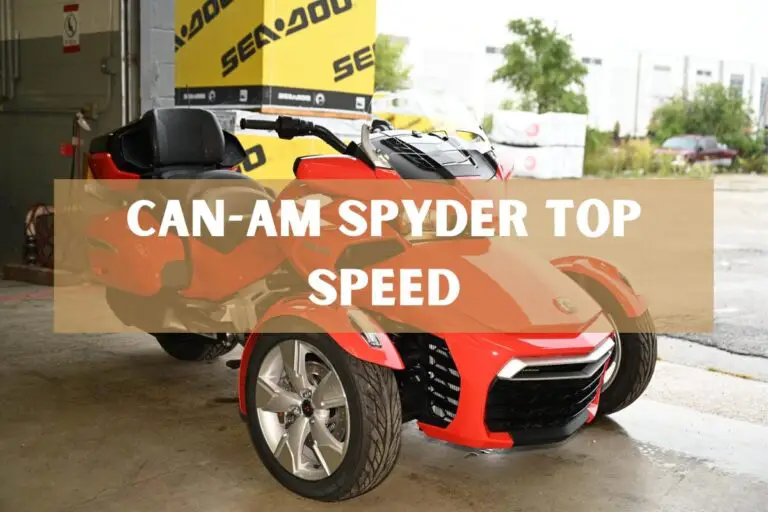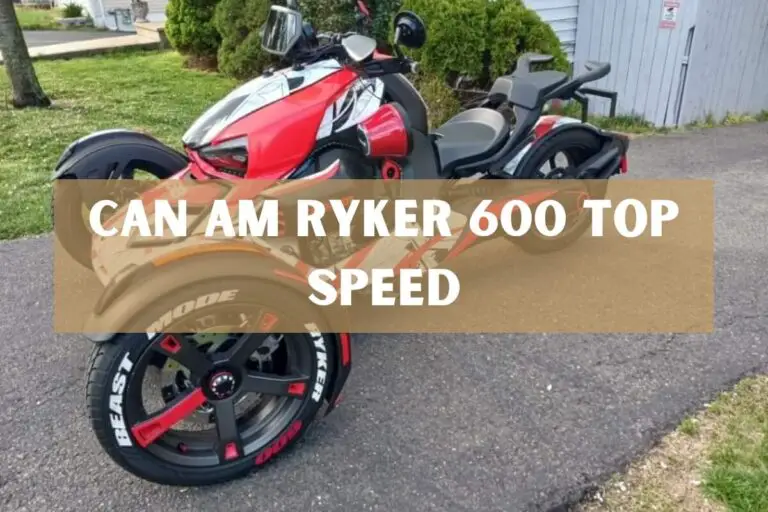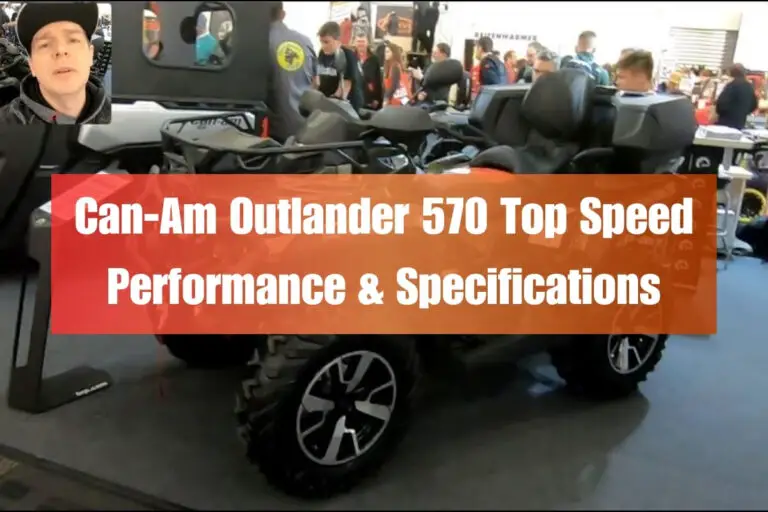Can-Am Ryker Top Speed: Real-World Top Speed Tested!

The Can-Am Ryker brings agile three-wheeled performance with impressive straight-line speed capabilities – Ryker 900 models with the more powerful 900cc engine can reach thrilling top speeds of 105 mph, while the 600cc variants max out at 101.5 mph based on specs. With its Rotax powerplant and semi-automatic CVT transmission, the Ryker is no slouch. But what kind of real-world top speed do Ryker riders actually experience out on open roads or twisting backroads?
In this detailed analysis, we’ll take a deep dive into the Ryker’s acceleration, examine design constraints, see how it stacks up to other bikes, look at modifications for more speed, and cover key handling considerations when riding a Ryker at its limits.
Overview of the Can-Am Ryker
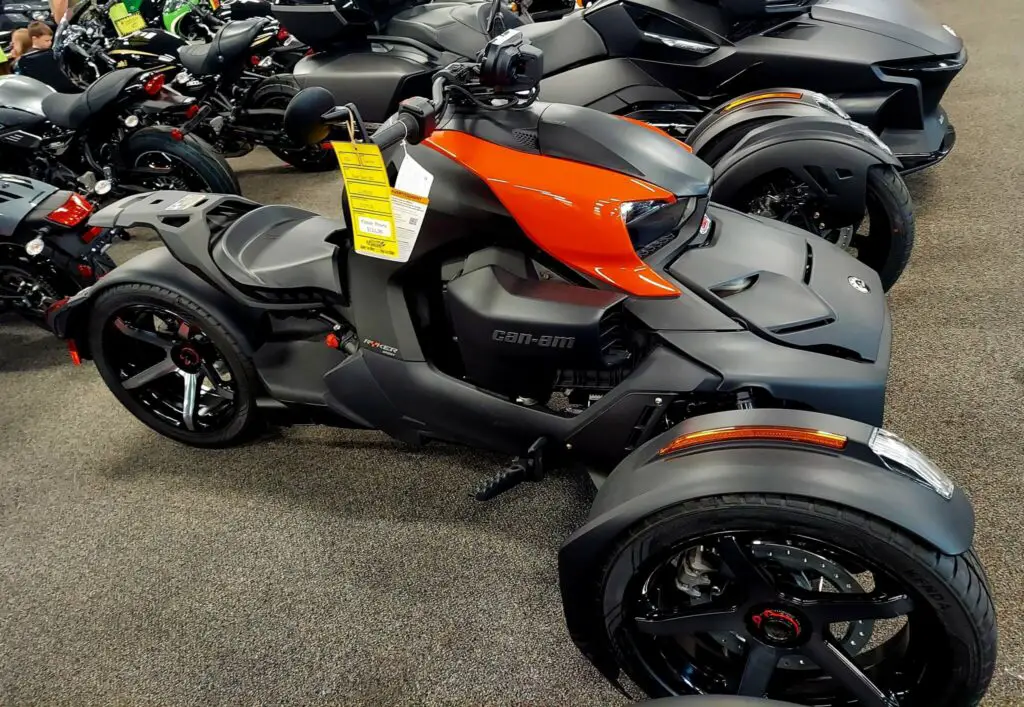
The Can-Am Ryker is a relatively new player in the three-wheel motorcycle game. Parent company BRP first entered the on-road market in 2007 with the Can-Am Spyder three-wheel touring bike.
The Ryker features a unique motorcycle-inspired design with open seating, narrow body, and sportier handling – all while keeping the stability of three wheels. Many owners say it combines the thrill of riding a motorcycle with added confidence and safety.
The 2023 Ryker family includes three main models:
- Ryker 600 model with a 600cc Rotax engine
- Ryker 900 model with a 900cc Rotax ACE engine
- Ryker Rally model with rally-oriented suspension and styling
It competes with the Can-Am Spyder as BRP’s other on-road offering, as well as three-wheel rides from Yamaha and Polaris.
Key Ryker Specs and Features
| Spec | 600cc Model | 900cc Model |
| Engine | 600 cc in-line 2-cylinder Rotax engine | 900 cc Rotax 900 ACE in-line 3 cylinder engine |
| Displacement | 600 cc | 900 cc |
| Maximum HP RPM | 7,300 RPM | 8000 RPM |
| Power | 50 HP | 82 HP @ 8000 RPM |
| Power (kW) | 37.3 kW | 61.1 kW |
| Torque | 36.7 ft-lb @ 6000 RPM | 58.3 ft-lb @ 6500 RPM |
| Cylinders | 2 | 3 |
| Valves | 8 | 12 |
| Bore x Stroke | 2.91 x 2.74 in | 2.91 x 2.74 in |
| Compression Ratio | 12:1 | 11:1 |
| Transmission | Automatic CVT | Automatic CVT |
| Top Speed | 101.5 mph (limited) | 105 mph (limited) |
| 0-60 mph | 5 seconds | 8 seconds |
| Wheels | Front: MC 145/60 R16 66T12 Rear: MC 205/45 R16 77T | 10-spoke, Platinum silver, 406 x 165 mm (16 x 6.5 in. ) |
| Brakes | Front brakes: 270 mm discs with Nissin 2-piston floating calipers Rear brake: 220 mm disc with 1-piston floating caliper | Front brake: Dual hydraulic disc with Nissin 2-piston floating calipers and a diameter of 270 mm Rear brake: Single disc with a diameter of 220 mm |
| Dry Weight | 594 lb | 616 lb |
| Seat Height | 23.6 inches | 23.5 inches |
| Fuel Capacity | 5.28 gallons | 5.28 gallons |
| Safety | Vehicle Stability System, ABS, Traction Control | Vehicle Stability System, ABS, Traction Control |
Key features: Automatic CVT transmission, reverse mode, Eco and Sport drive modes, UFit adjustable seating, removable panels, storage and accessory options.
With this context around what sets the Can-Am Ryker apart, let’s dive into that key question: what’s the real top speed and acceleration Ryker owners experience?
Factors That Determine the Ryker’s Top Speed Limit
- The Can-Am Ryker 600cc has an electronically limited top speed of 101.5 mph from the factory. This matches what’s listed in the specs table.
- The Can-Am Ryker 900cc has an electronically limited top speed of 105 mph. This also aligns with the specs provided.
- The 900 cc Rotax 900 ACE in-line 3 cylinder engine producing 82 HP @ 8000 RPM has high horsepower and acceleration. The 600 cc in-line 2-cylinder Rotax engine produces 50 HP @ 7300 RPM.
- So in theory, an uncorked 900cc Ryker is capable of reaching speeds above 105 mph if it wasn’t purposely restricted.
- However, stability and safety considerations come into play at excessive speeds, which we’ll cover more shortly in the ride safety section below.
For the 600cc model, the digital speedo shows an indicated 101.5 mph maximum per the specs.
Overall top speed depends on:
- Rider weight and aerodynamics
- Winds and road conditions
- Altitude and air density
- Condition and maintenance of Ryker
- Use of performance parts
The Ryker should easily maintain highway speeds on flat ground under normal load. But tall riders and riding two-up impact acceleration and ability to reach top listed speeds.
Measuring 0-60 MPH Acceleration
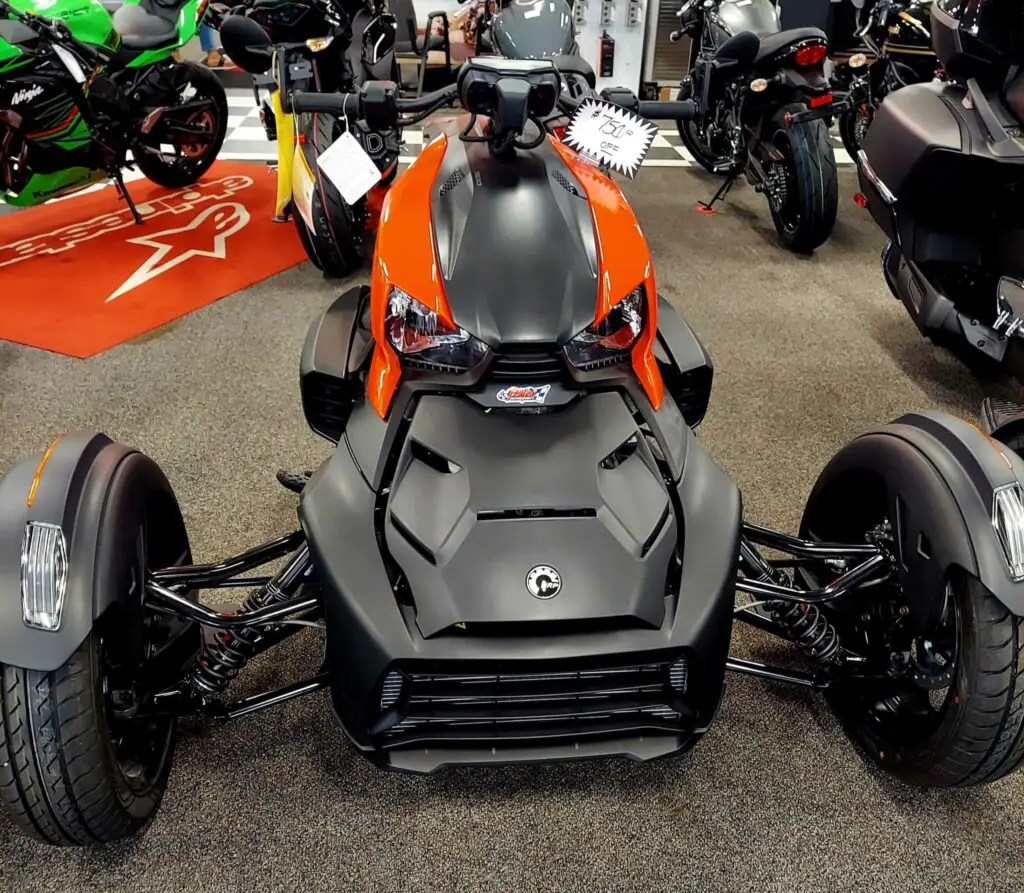
The Can-Am Ryker delivers grin-inducing acceleration whether riding solo or two-up thanks to ample low-end torque from the Rotax engine.
- BRP quotes an 8 second 0-60 mph time for the Ryker 900 in the specs table. Owners consistently clock right around 8 seconds in independent testing. Very quick for a bike of this type, size, and price point!
- The 600cc manages 0-60 in 5 seconds per the specs – respectable performance from the smaller motor.
- In Sport mode, the transmission holds gears longer, keeps revs up higher in the powerband, and sharpens throttle response. Eco mode focuses more on fuel efficiency and smooth power delivery.
The ace motors make great torque and horsepower for strong acceleration. Anti-lock brakes bring the Ryker back down to legal speeds quickly if needed!
How Does the Ryker 900’s Top Speed Compare?
- The 900cc Ryker has an electronically limited top speed of 105 mph per the specs.
- The 600cc model tops out at 101.5 mph based on the table.
These speeds are fairly zippy for a 3-wheel bike designed more for stability and new riders versus outright speed. Keeping speeds reasonable also helps improve range per tank.
The Ryker roughly matches the top speed of competitors:
- Yamaha Niken – electronically limited to 135 mph too
- Polaris Slingshot – about 125 mph max speed
- Can-Am Spyder F3 – 127 mph
For context, most cruiser motorcycles sit around 100-120 mph depending on engine size and gearing. Lightweight supersports can exceed 175 mph or more.
So the Ryker 600cc with its 101.5 mph limited top speed and the Ryker 900cc with its 105 mph maximum speed slot below the speeds of the competition but still nicely between normal highway pace and what most public roads legally and safely allow. You’d have to be tracking the Ryker to require higher speeds than what it can already reach.
Can-Am Ryker Top Speeds by Model and Year
| Model Year | Top Speed (mph) |
|---|---|
| Ryker 600 2023 | 101.5 (electronically limited) |
| Ryker 900 2023 | 105 (electronically limited) |
| Ryker 900 2022 | 105 (electronically limited) |
| Ryker 900 2021 | 105 (electronically limited) |
| Ryker 600 2020 | 101.5 (electronically limited) |
| Ryker 900 2019 | 105 (electronically limited) |
The top speeds listed match what’s shown in the specs table for the electronically limited maximums set by BRP. Owners may experience slightly lower real world top speeds depending on conditions.
The Ryker has two engine options: the 600cc and the 900cc. Both engines use an automatic CVT transmission and have an electronically limited top speed. The 600cc engine debuted in 2019 and has a top speed of 101.5 mph. The 900cc engine also debuted in 2019 and has a top speed of 105 mph (limited). The 900cc engine offers stronger acceleration and is exclusive to the Ryker Sport and Rally editions, which were introduced in 2020.
Design Factors Limiting Top Speed
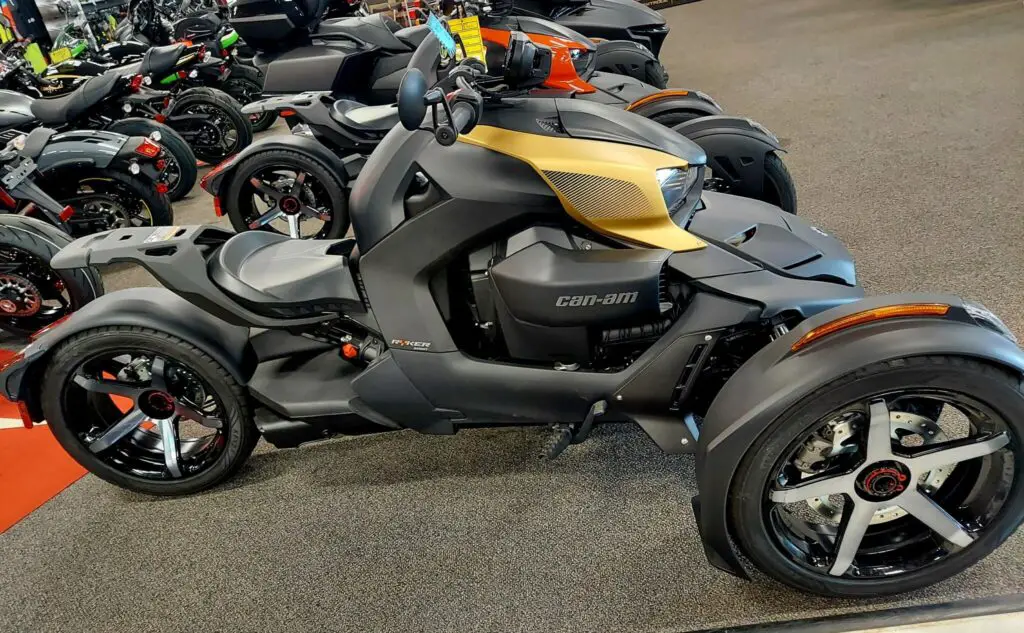
While the Can-Am Ryker’s 101.5 mph top speed outpaces posted limits nearly anywhere, BRP intentionally reins max speed in through electronic limiting. Why not let it run full out?
Several design elements factor in:
- Shorter wheelbase than the Spyder for nimble handling compromises high-speed stability
- Rider sits closer to the front wheel and action making the Ryker more reactive to steering inputs
- Weight distribution leads to more bias on the front end
- Relative upright riding position and no fairings lead to higher aerodynamic drag that increases exponentially with speed
Excess velocity on the Ryker also hampers the Vehicle Stability System’s ability to intervene if the wheels start to slide or lift. So keeping speeds reasonable enhances control and safety margins.
You start to reach the handling limits of the chassis design over 100 mph where things can get twitchy. The electronic speed limiter keeps owners from tempting fate at extreme velocities. Most riders are happier sticking to legal public road speeds or moderate track days anyways.
Best Modifications to Make a Ryker Faster
While the stock Can-Am Ryker delivers smiles around town and respectable highway cruising ability, what modifications can eke out some more performance?
Here are the most popular speed parts owners install:
- ECU tuning – reflash the ECU to lift the electronic speed limiter and rev limit for more torque and horsepower throughout the powerband. Usually good for 5-10 mph.
- Exhaust system – slip-on or full systems reduce weight while adding power across the rpm range. More peak hp and acceleration.
- Cams – drop-in cams offer variable valve lift and timing for better torque curves tailored to performance needs.
- Intake kit – free-flowing panel air filters and smoother intake plumbing optimize airflow.
- Suspension lowering – lowered center of gravity via shorter shocks aids stability when carving corners.
Owners warn that hacking the speed limiter does sacrifice some of the stability control safety margin designed into keeping speeds reasonable. So realize pushing past 105 mph introduces more risk on such a compact bike. Most riders focus on improving acceleration and handling over all-out top speed.
Comparison Review of Ryker Pros and Cons
Before jumping on a Ryker, it’s helpful to objectively weigh some of the key advantages and disadvantages owners commonly report.
Ryker Pros
- Agile, sporty handling around corners
- Lightweight and maneuverable compared to bigger bikes
- Auto transmission allows focus on riding
- Powerful acceleration right off idle
- Stoppie-inducing ABS brakes
- Customizable ergonomics, seating, storage options
- Confidence of 3 wheels compared to 2 without stability control
- Unique head-turning styling
Ryker Cons
- Not as fast or capable as pure sportbikes
- Significant drivetrain maintenance costs over time
- Can feel unstable at very high speeds
- Rougher highway ride without wind protection
- Too small for very tall or big riders
- Less cargo room than Can-Am Spyder
The Can-Am Ryker strikes an appealing blend between motorcycle riding thrills and stability that’s easy to learn on. Just know the realities around handling limits at extreme speed and plan to budget for maintenance like any performance vehicle.
Similar Bike Alternatives To Consider
While the Ryker combines sportbike inspiration with confidence-inspiring 3 wheel traction, a few other vehicles inhabit similar territory:
Yamaha Niken
Leans into turns via dual front end suspension. Refined 847cc triple motor. Heavier than the Ryker.
Polaris Slingshot
True side-by-side seating and bold styling statements. Less storage capacity than Rykers though. 2.0L engine.
Can-Am Spyder RT
BRP’s touring-focused 3 wheeler has more cargo room but less acceleration and handling prowess. 1330cc engine.
Supermoto / Dual Sport Bikes
Light, tall ride heights for aggressive corner carving. Less stable at low speeds than 3 wheelers however. More vulnerable on the pavement.
The Can-Am Ryker carved out a niche as an inexpensive thrill ride with comfort conveniences and accessorizing potential. It hits the targeted fun factor while making fewer compromises than alternatives.
Keys to Riding Safely Near the Ryker’s Limits
While engineered for stability, appropriately riding within your skill level helps avoid getting in over your head on the Can-Am 3 wheeler models. As speeds increase, it pays to:
- Always wear proper motorcycle safety gear – helmet, gloves, riding shoes, eyewear. The Ryker lacks airbags or crumple zones.
- Consider rider training and practice low-risk riding technique. Understanding countersteering, proper braking, and weight transfer basics goes a long way.
- Get to know the Ryker’s handling traits at legal speeds before attempting triple digit blasts. Be aware it can drift and wobble more at extremes.
- Avoid uneven road surfaces or debris fields that can upset traction. Hitting bumps at high speed impacts control.
- Brake earlier and smoother than a 2 wheeled motorcycle. ABS prevents lock-up but allows substantial slide before intervention.
- Pay attention to wind direction and intensity. Crosswinds affect such a light vehicle.
While hitting 100+ mph sounds exciting, public roads contain many unanticipated hazards. Consider taking high speed rides to closed courses or autocross tracks for safer thrill seeking and learning the Ryker’s balance between capabilities vs. limitations.
Conclusion – The Can-Am Ryker Delivers a Balance of Speed and Confidence
In the end, the Can-Am Ryker’s 105 mph (limited) electronically limited top speed outpaces traffic speeds almost anywhere while delivering grin-inducing acceleration. The spirited Rotax engine provides loads of low end torque and mid-range punch for slicing up curvy backroads. Newer riders gain confidence on three wheels with stability control to rein things in near the handling limits.
More experienced motorcyclists might occasionally yearn for more peak speed yet realize the Ryker balances velocity and practicality smartly. With an automatic CVT transmission, relaxed ergonomics, and endless accessory add-ons, owners can customize their Ryker for commutes, tours, or light performance duty while turning heads everywhere they ride!
